

Pluto, named after the Roman god of the underworld, is the largest member of the group of icy outer Solar System bodies that make up the distant Kuiper Belt. This asteroid-belt-like collection of objects lies beyond the orbit of Neptune. In the late 1800's and early 1900's, astronomers predicted a ninth planet beyond Neptune. Clyde Tombaugh discovered Pluto on February 18, 1930, by observing the movement of an object across pairs of images taken with an Arizona telescope. Upon discovery, Pluto was called the ninth planet. However, since 2006, considerable debate about whether Pluto is a real planet has ensued.
Until recently, very little was known about tiny Pluto except what could be determined from telescopic observations, with the best images coming from the Hubble Space Telescope. In July of 2015 that changed in dramatic fashion. The New Horizons spacecraft raced past Pluto, imaging one hemisphere in detail. The New Horizons images revealed a beautiful and geologically diverse world--to the complete surprise of all. The new images and data will fuel the study of Pluto for years to come and lead us to a better understanding of Pluto, other planets and moons, and the icy bodies of the outer Solar System.
Pluto's physical characteristics and features are different from any of the other planets we have seen so far (Table 13.1). Pluto is small, with a diameter (2,377 km) only 70% that of Earth's Moon. It is also 40 times farther from the Sun than the Earth. Pluto's orbit is highly elliptical and inclined to the ecliptic by 17° (Figure 13.2a and b). Only asteroids and comets have similarly inclined orbits. Moreover, Pluto's orbit is in a 2:3 resonance with Neptune. Pluto takes 248 Earth years to complete one orbit, and one day on Pluto is 6.4 Earth days. Pluto's spin axis is strongly tilted (120°); basically, it rolls along its long orbit around the Sun like Uranus (as seen in this video). The severe tilt can cause extreme seasonal changes, especially at the poles, which can experience arctic winter and arctic summer. Pluto's surface is covered by highly volatile ices of nitrogen, methane (like Neptune's moon Triton) and carbon monoxide; these ices sublime (vaporize) to form a thin atmosphere. The density of Pluto is 1.9 g/cm3, a result of the large proportions of ices that were present in the ancient accretion disk this far out from the Sun. Pluto's surface temperature ranges from 55 K (-218 °C) down to 32 K (-240 °C), or 32° above absolute zero - a very cold environment, indeed.
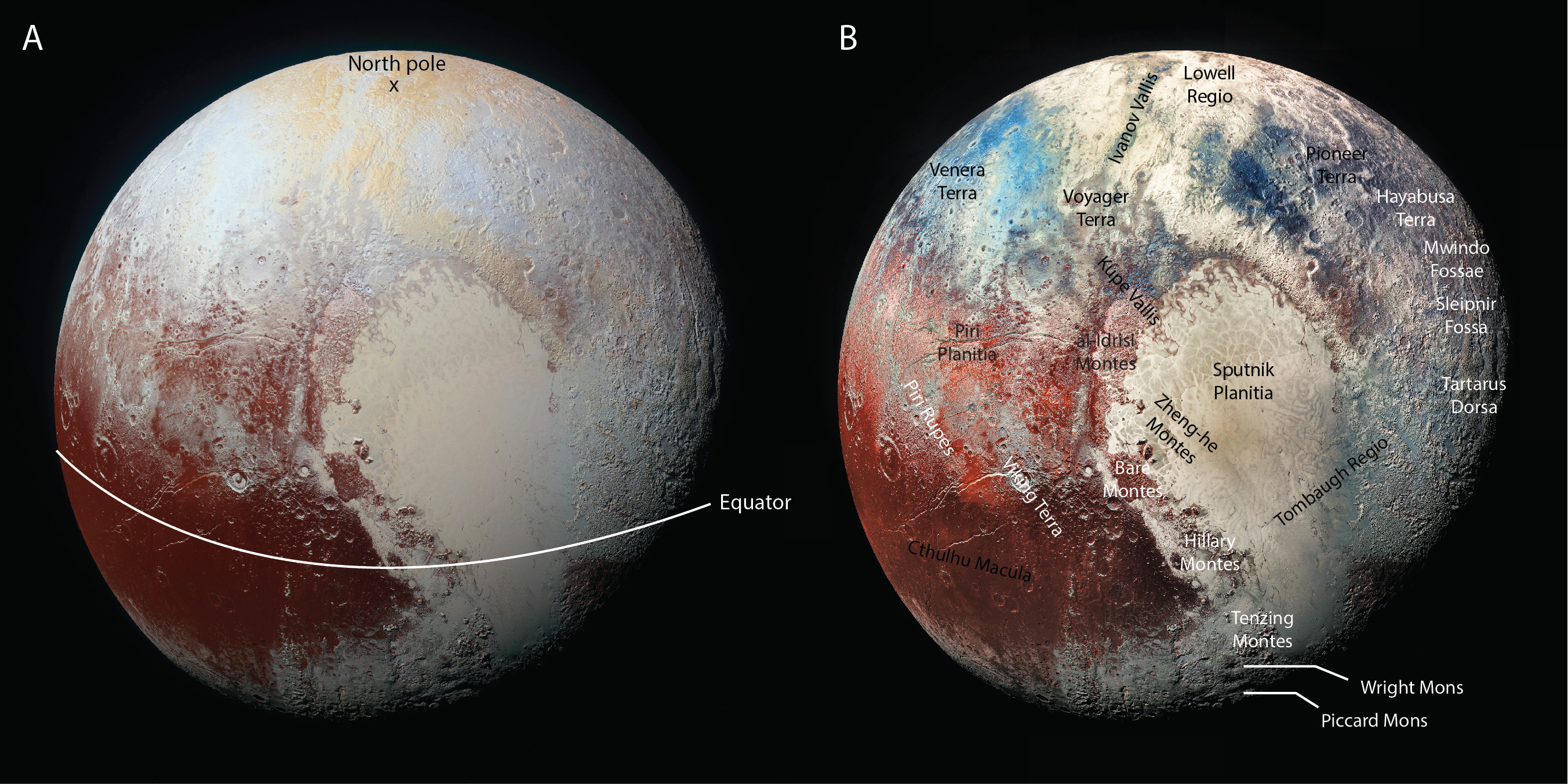
Pluto and three other "dwarf planets" (Eris, Haumea, and Makemake, with several others proposed) are located in an area of the outer Solar System known as the Kuiper belt. This is a disk that spans from 30 AU (just beyond Neptune's orbit) to 50 AU from the Sun and is reminiscent of the asteroid belt, in that it contains small bodies of leftover material from the solar nebula. Because of its great distance from the Sun, the Kuiper belt contains planetary bodies rich in the volatile ices--water, nitrogen, methane, ammonia, and carbon monoxide, instead of being metal- and rock-rich like the objects in the asteroid belt. Study of Pluto gives us insight into the origin and evolution of Kuiper Belt Objects (KBOs).
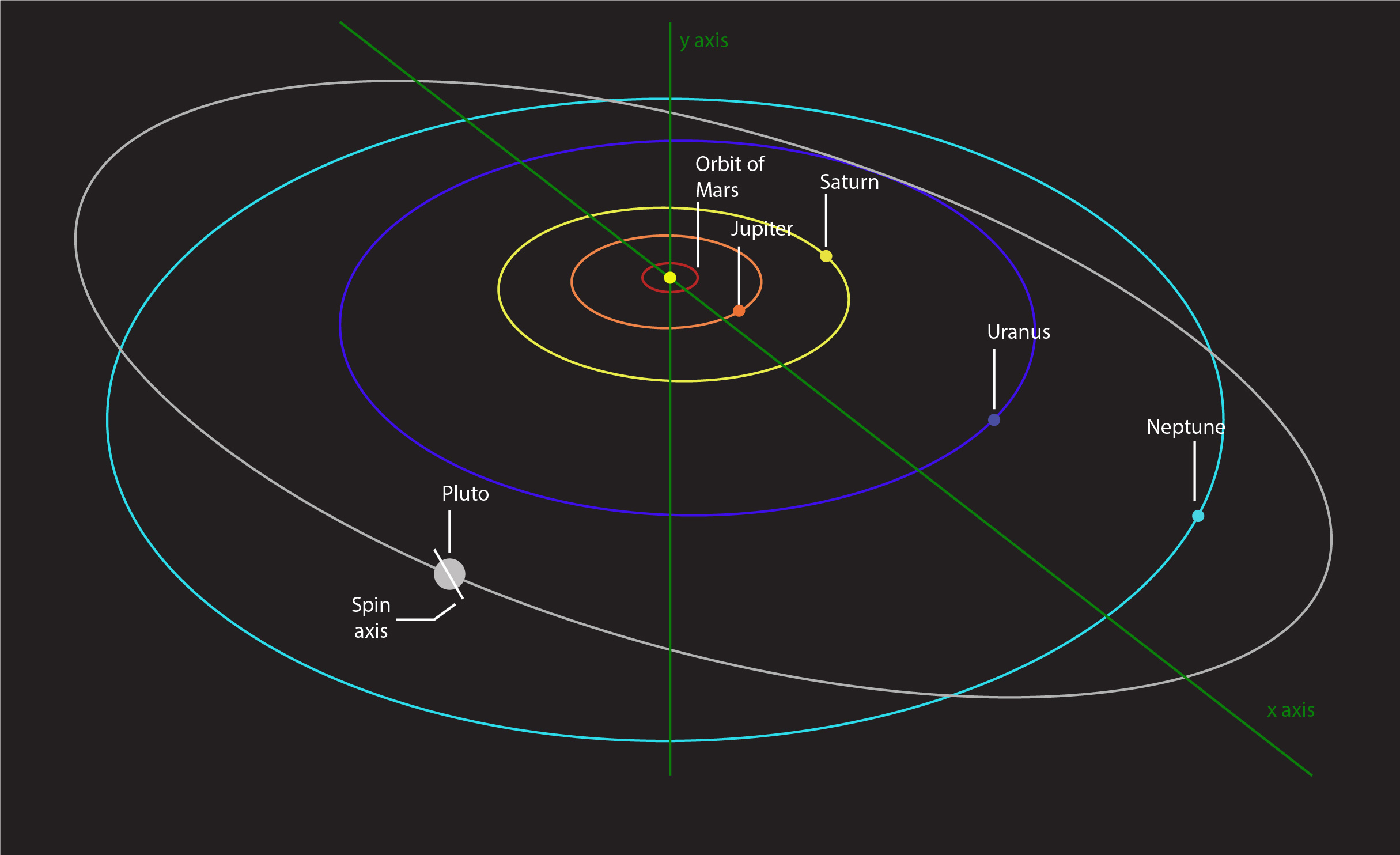
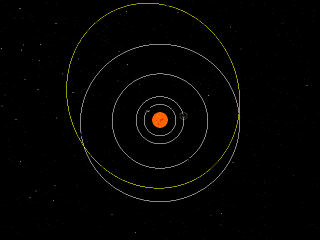
Pluto's classification as a planet was questioned after the discovery of multiple Pluto-like bodies in the outer Solar System. This elicited the following "problem." Either there are many more planets than the traditional nine, or Pluto (and the newly discovered bodies) should not be considered to be a true planet. In August 2006, the International Astronomical Union (IAU) revised the definition of planet to exclude Pluto, reclassifying Pluto as a "dwarf planet," by saying that a planet needs to a) be round, b) orbit the Sun, and c) clear its orbit. Although Pluto is round and orbits the Sun, it has not swept up all of the orbiting "debris" in its path. However, others disagree with this reclassification as a dwarf planet. Led by Alan Stern (who headed the New Horizons mission), a group of planetary scientists created a different definition: "A planet is a sub-stellar-mass body that has never undergone nuclear fusion and that has sufficient self-gravitation to assume a spheroidal shape... regardless of its orbital parameters." This definition indicates that a body is a planet if it is round and doesn't make its own internal energy. Debate of the definition of a planet, and Pluto's status as a planet, is still ongoing.
Pluto's small size and distance from the Sun have made it difficult to study. The arrival of New Horizons meant that our understanding went from a body of about 20 pixels across to a completely fleshed out picture of a planetary body with recent processes and a long and eventful geologic history. The New Horizons findings have helped us understand the formation and subsequent evolution of small, distant, icy bodies, which can be directly contrasted with the terrestrial planets
Like the Earth, Pluto experiences seasons because of planet's axial tilt. Since Pluto has a much greater axial tilt (120°) than the Earth's (24°), the arctic and antarctic circles are much larger on Pluto, extending from nearly 30° north and south of the equator all the way to the pole, compared with just 66° on Earth (Figure 13.3). Strangely, at the height of Pluto's summer, the most direct sunlight is located within the arctic circle, not the mid-latitudes like we experience. Currently, Pluto's northern hemisphere is in the summer season, while the southern hemisphere is in winter and complete darkness. Presently, the direct and continuous sunlight on the northern hemisphere is causing nitrogen ice to sublime from the north pole and enter the atmosphere or freeze out on the cold south pole. The amount of sunlight each area on Pluto is receiving is a major contributor to the distribution of volatile ices on Pluto's surface.
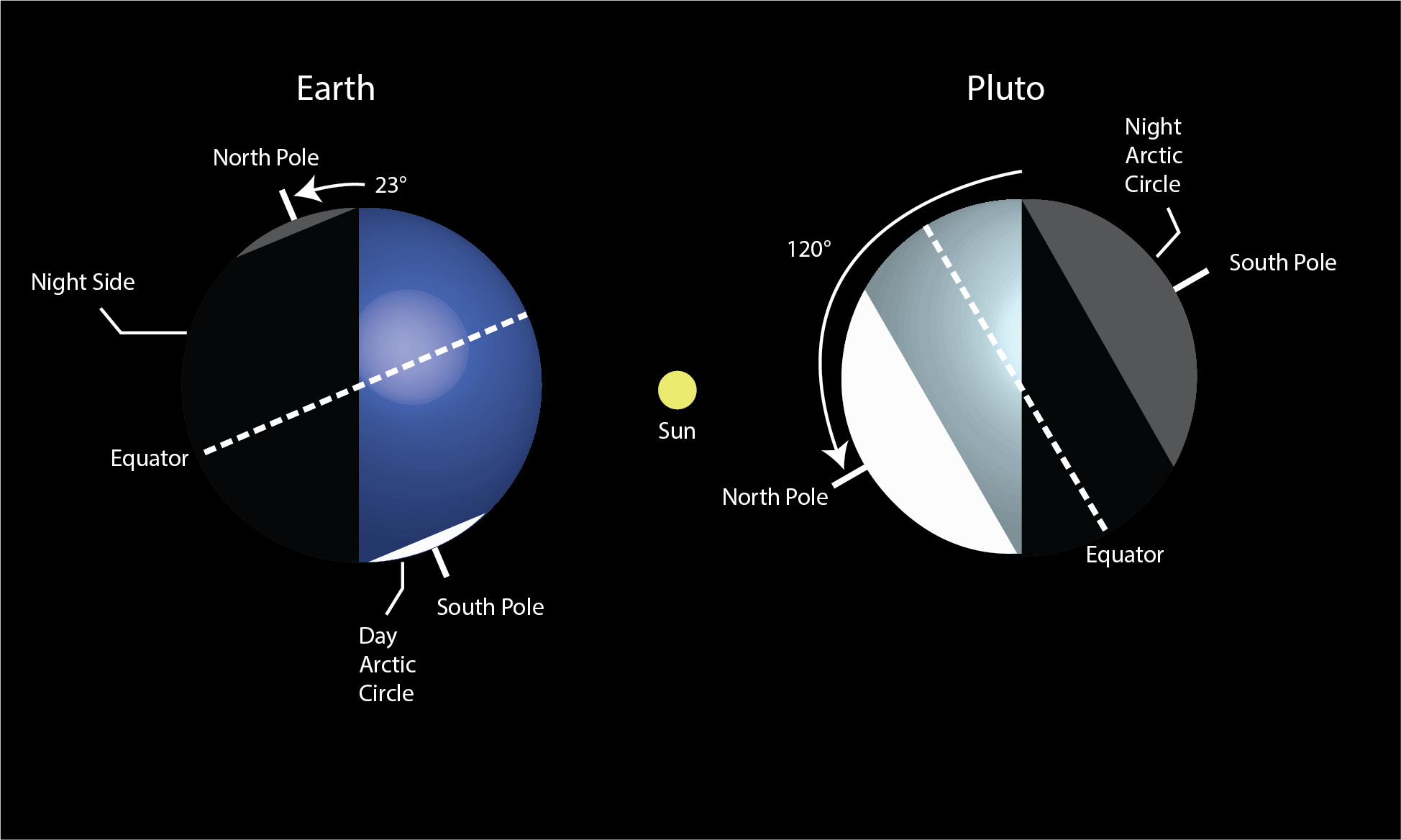
Pluto's surface is composed of four primary ices (three of which are shown in Figure 13.4). The most prevalent ice is water ice (with traces of mixed in ammonia). Water ice was detected on the surface or just below (covered by a thin blanket of more volatile ices) by New Horizons in all major regions on Pluto, with the exceptions of Sputnik Planitia and the northern polar region. Similar to the icy satellites of Jupiter and Saturn, water ice forms the lithosphere and "bedrock" of Pluto. It is by far the most abundant of all the ices, and based on Pluto's density, probably makes up almost 50% of the planet by volume. Of the four ices, only water ice is strong enough to build up topography without collapsing under its own weight. This means that all rugged mountains and mountain chains on Pluto are underlain by water ice, covered by a thin layer of more volatile ices. Just imagine looking out your window to stare at mountains 4-5 km high that are made completely of water ice instead of rock!
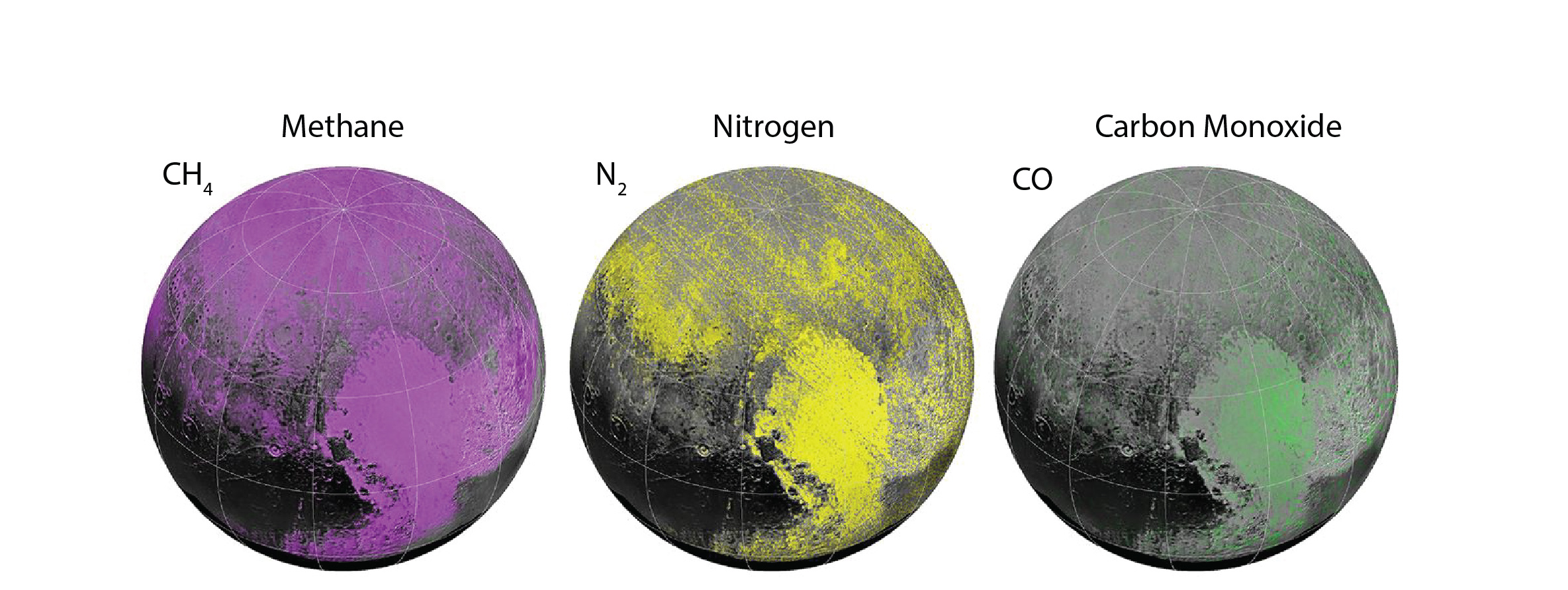
The remaining ices are nitrogen (N2), carbon monoxide (CO), and methane (CH4), listed in order of decreasing volatility. Some other physical characteristics of these ices are shown in Table 13.2. Consider how cold it must be on Pluto to have solid nitrogen -- the main atmospheric gas on Earth and Titan -- frozen onto the surface as an ice. The volatile ices cover most of the surface, so that the water ice bedrock does not peak through in many areas. Sputnik Planitia, a deep basin, has high concentrations of all of these ices, especially nitrogen. Because of Pluto's tilted spin axis, Sputnik Planitia faces away from the Sun, and temperatures are low, stabilizing solid nitrogen. In contrast, the north polar region is enriched in methane and poor in nitrogen because it is more often directly facing the Sun, causing the more volatile ice (nitrogen) to sublime. Western Tombaugh Regio also has high concentrations of methane that have not been covered by tholins, or organic-rich material, that have fallen out of the atmosphere, most likely because it is colder at these higher elevations. Carbon monoxide is not abundant on Pluto, and only found in semi-high concentrations within Sputnik Planitia (Figure 13.4). These ices are surficial and are not a major part of Pluto's bulk composition.
We have mentioned the "atmosphere" of Pluto multiple times, but it is a very, very thin atmosphere with a pressure of less than 10 microbars (0.1% that of Earth's). Even at that low pressure, the molecules interact by colliding with one another, creating a gas that can flow in response to pressure and temperature differences-unlike the isolated molecules in the even more tenuous exospheres of the Galilean satellites or Mercury. Unexpectedly, there is evidence the atmosphere of Pluto is dense enough to transport ice particles and deposit them in sand dunes (Figure 13.7). Apparently, wind blows from the high al-Idrisi Montes down into the basin of Sputnik Planitia, carrying some of a dusting of methane "snow" that has fallen or condensed at the top of the montes. The methane sediment is then deposited as dunes on Sputnik Planitia.
The composition of Pluto's atmosphere is like the composition of the surface veneer. The atmosphere contains a lot of nitrogen with lesser methane, and some other hydrocarbons as well. The similarity in composition between the surface veneer and the atmosphere is a result of sublimation of the volatile ices. The surface temperature is so close to their sublimation point that small seasonal oscillations in temperature can cause the ices to sublime in one place and condense in others. Thus, these ices escape easily into the atmosphere that reflects the composition of the solid surface. This is quite different from Earth and many other planets where the volatile envelope bears little resemblance to the composition of the solids on the surface.
The surface of Pluto is covered by volatile ices that are deposited, eroded, and transported. Erosion of these ices has produced different provinces that most likely have formed by deposition and erosion of ice (including glacial flow) with small variations that create different morphologies (Figure 13.5).
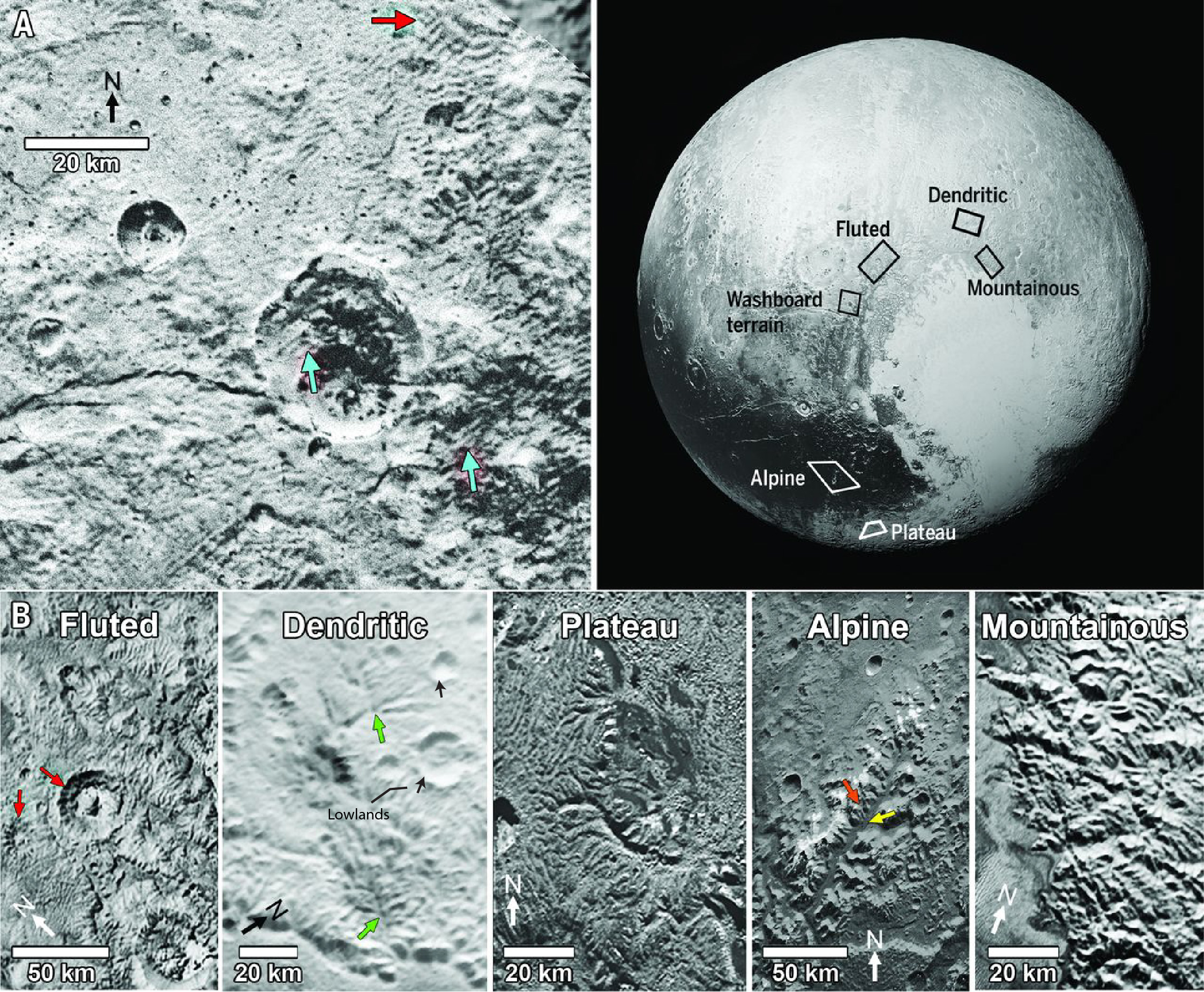
The washboard terrain lies directly west of al-Idrisi Montes (see Figure 13.1). It is made of parallel ridges and grooves with crest to crest distances of about 1 km. The ridges and grooves run from NE to SW; they are superposed on top of all impact craters showing they are quite young. The washboard appears to be a thin, regional deposit perhaps similar to dunes, or it could be the partially eroded remnants of a volatile ice deposit or features formed by tectonic or landslide processes.
One of the most amazing terrains on Pluto is the dissected terrain (Figure 13.5 bottom row). This terrain of sinuous and dendritic valleys was completely unexpected on this world where everything was thought to be frozen solid. Each valley is oriented downhill, suggesting something flowing incised into the ice. However, the valleys terminate into depressions with no obvious deposits. Here on Earth, even the ends of dry rivers have alluvial fan deposits. Did the material sublimate after being deposited? In some instances, smaller valleys merge into a larger valley, similar to feeder systems of rivers and glaciers on Earth. These valleys look to have been formed by erosive glacial activity of nitrogen ice, similar to the active valley glaciers seen in the Tombaugh Regio.
Named after the discoverer of Pluto, Tombaugh Regio is a unique, heart-shaped region mostly north of Pluto's equator (Figure 13.1). The western half is a large basin, filled with a smooth, impact crater-free, nitrogen-ice ice sheet known as Sputnik Planitia. The eastern half is an upland of methane ice pitted by sublimation and cut by nitrogen glaciers.
Sputnik Planitia is a broad basin 3-4 km deep and a thousand km across that forms the western half of Pluto's heart (Figure 13.6). The original depression may have formed by a major impact in Pluto's distant geologic past. Today, the basin is filled by a sheet of young, nitrogen-rich ice (see Figure 13.4). The bright ice sheet is broken up into polygonal shapes separated by 100 m deep trenches (Figure 13.6). The polygons are 20 to 40 km across, with the centers raised ~50 m above their margins. Within some of the polygons and along the margins, blocks of water ice appear to "floating" in the nitrogen ice. The diameter of the cells and the dimensions of the floating, water-ice mountains indicate the ice sheet is about 10 km thick. Below the ice, lies a thin region of the water ice lithosphere and perhaps an uplifted section of a liquid water layer.
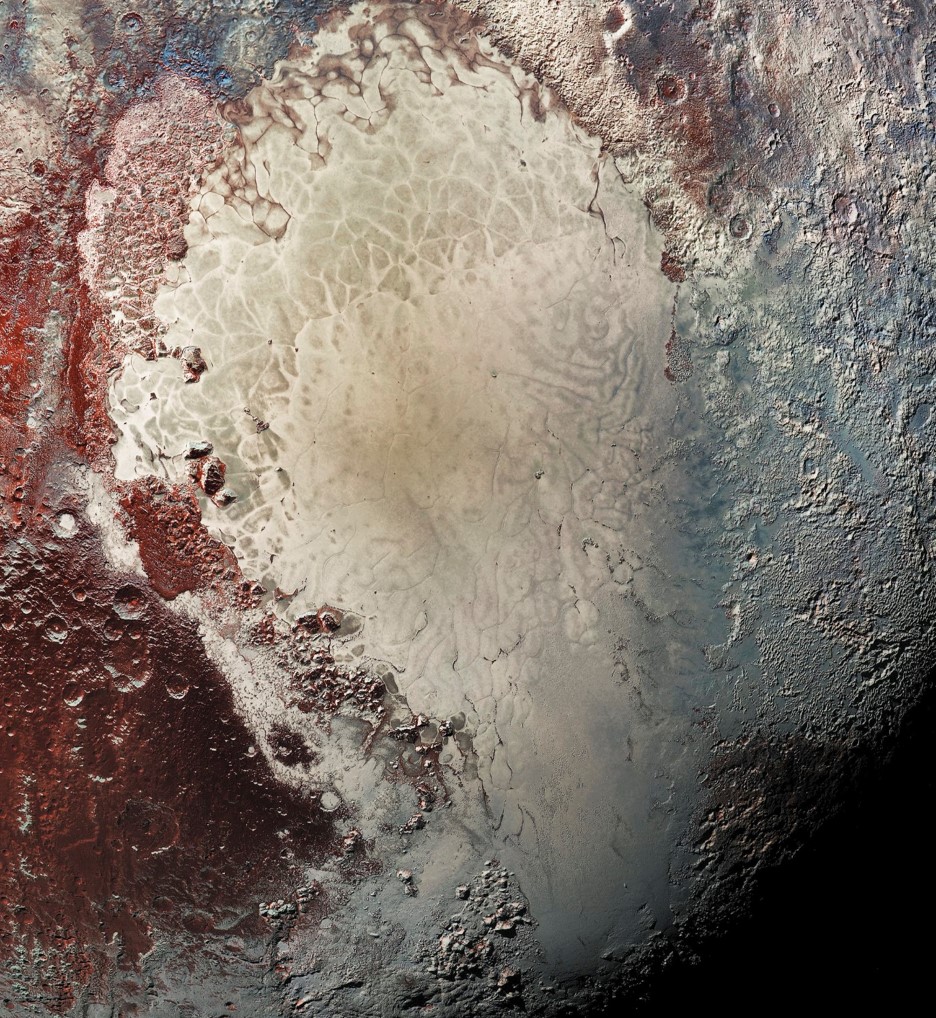
These polygonal shapes were perhaps the most exciting discovery on Pluto. They are reminiscent of the tops of convection cells, such as might form on a boiling pot of thick tomato soup, but this sheet is solid (but weak), not liquid. There may be enough radiogenic heat to sustain solid state convection in this weak layer of nitrogen, or convection could be driven by cooling from a previously warmer climate. This convection produces the polygonal cells by warmer ice rising in the middle part of the cell (elevating the central cell) and cold ice sinking at the cell boundary troughs (Figure 13.7). There is nothing else like this in the entire solar system. Imagine standing on icy terrain convecting and spreading beneath your feet -hundreds of tiny "plates" growing and then "subducting" at the margins. Mathematical models conclude that each cell might overturn in 100,000 to 1,000,000 years-so some polygons might be spreading at the same rate as Earth's (much larger) tectonic plates move.

Sputnik Planitia's western and southern regions are surrounded by Montes (mountains) rich in methane (CH4) ice, quite different from the nitrogen ice that fills the basin (Figure 13.1 and 13.4). However, on Pluto, solid methane is weak and unable to support the topography of a mountain without flowing and deforming under its own weight. On the other hand, water ice is common on Pluto, as indicated by its density, and is strong enough to support topography at such low temperatures; at Pluto's low surface temperature water ice is basically as strong as silicate rock on Earth. Consequently, the methane is most likely a thin veneer covering water ice mountains. One of the most notable mountain regions is the al-Idrisi Montes, on the northwestern edge of Sputnik Planitia (Figure 13.1). It has randomly oriented blocks of ice that are an amazing 5 km high and 40 km across. They form a rough chain of mountains extending for 100s of km (Figure 13.8). For perspective, Earth's Tibetan Plateau rises about 5 km above the plains of India and Valles Marineris on Mars is about 7 km deep. The blocks of al-Idrisi have flat or gently sloping upper surfaces with a series of irregular knobs that are like features in the surrounding terrain. This suggests the blocks broke away from the highlands to the west and slid chaotically into the lower basin.
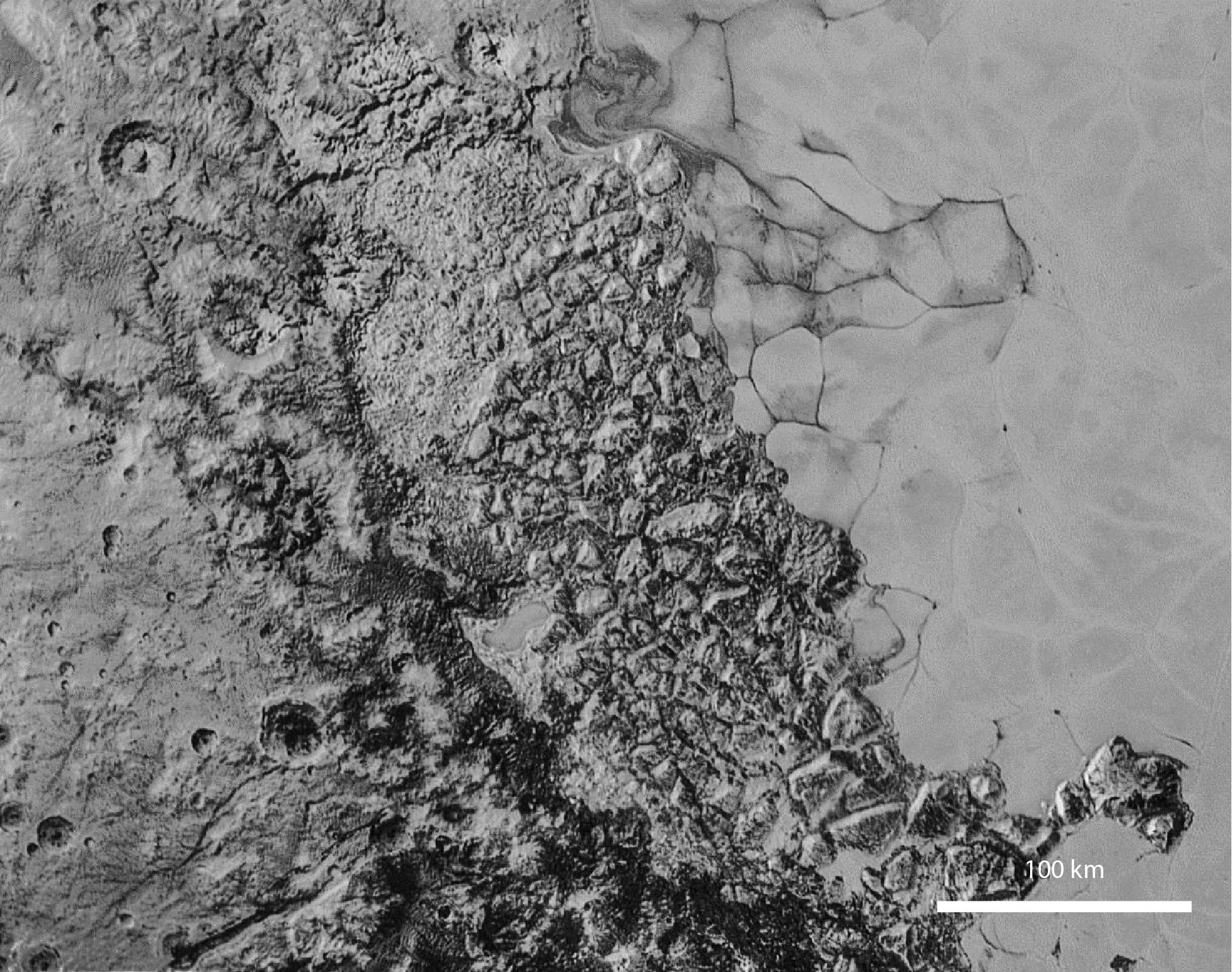
The eastern pitted highlands extend 4 km above Sputnik Planitia and are very different from the western lobe of Tombaugh Regio. It is a heavily pitted upland or highland terrain (Figure 13.9). The highlands composition is different than Sputnik's; methane is the dominant ice with lesser nitrogen and carbon monoxide (Figure 13.4). Individual pits cover the highlands and range in diameter from a few km to 25 km across. The floors of the pits may be smooth soft, deformable nitrogen ice. Smooth plains stretch between multiple pits and are up to 50 km wide.
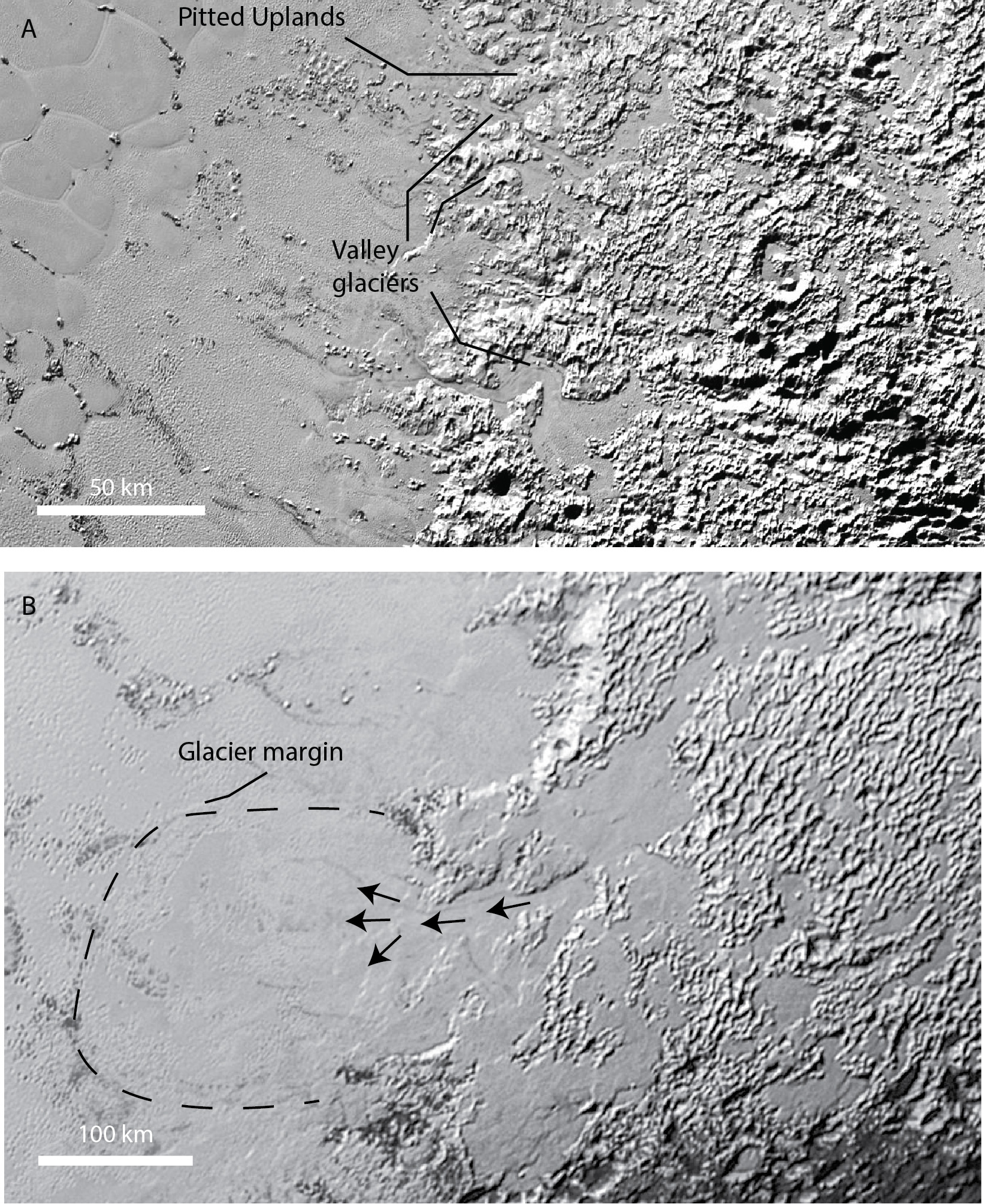
The uplands may have originally been a thick smooth deposit of methane ice mixed with nitrogen. As the more volatile nitrogen vaporized it eroded the highlands during the last/current "interglacial period" (warmer climate) in the region.
The expectation that Pluto's surface was geologically "dead" was shattered by the discovery of active glaciation around and within Sputnik Planitia. Valley glaciers originate in the uplands, west of Sputnik Planitia, and flow down into the basin enlarging some of the troughs formed by sublimation. The tongues of glacial ice are outlined by medial and marginal moraines that show up as darker streaks in the elongate lobes-just like terrestrial glaciers (Figure 13.9). But these glaciers are not flowing masses of water ice-instead they are made of nitrogen ice which is weak and can flow even at the low temperature of Pluto's surface.
Sublimation is a commonly occurring process on Pluto that drives the formation of innumerable observed pits. These pits can be seen across most of Pluto's surface, with obvious pits in the pitted uplands (previously described) and on the plains of Sputnik Planitia (Figure 13.10). They form in nitrogen-rich ice, the most volatile and therefore the easiest to sublimate. We can best envision how they form by examining those on Sputnik Planitia, where the pits are small and shallow, only 10s of meters deep. In some locations, the patterns of pits show they form along anisotropies in the ice (flow margins, fractures, or compositional differences in the ice). As sublimation continues, the pits grow and merge leaving rough residual highlands between troughs. In the pitted uplands, the pits are much deeper (up to 2 km), irregular, and large than on Sputnik Planitia (Figure 13.9). They appear to have grown and merged with one another much more extensively than on Sputnik, implying the process has been going on for a much longer time than on the youthful Sputnik Planitia.
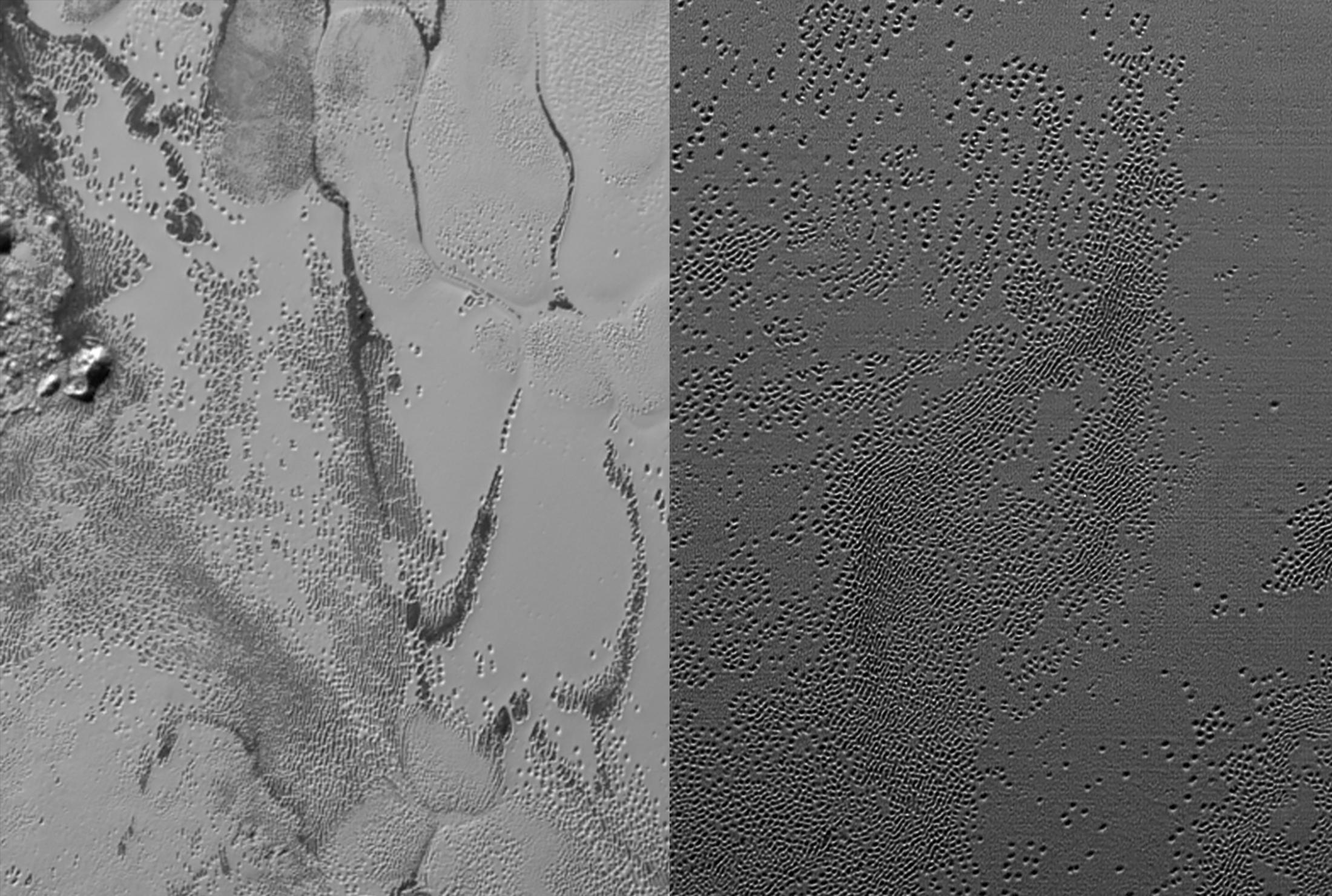
East of the pitted uplands is Tartarus Dorsa (Figure 13.1), which is made of several broad swells that are covered with N-S oriented, blade-shaped ridges with long narrow valleys between them (Figure 13.11). This region has been named Tartarus Dorsa. (In Greek mythology, tartarus was the deep abyss used as a dungeon for tormenting the wicked and a prison for the Titans; dorsa means back or top.) The steep-sided ridges are several hundred meters high and 5-10 km apart. These blades are located near the equator and are made mostly of methane ice. The blades (called penitentes on Earth where they form in snow) are probably a result of sublimation and wall collapse, forming elongate depressions that face the Sun and spires of non-sublimated ice, but some have suggested formation by preferential deposition of ice. The consistent orientation of the blades suggests there is a factor that determines the orientation, such as solar illumination, wind direction, or a regional fracture network.

The large dark equatorial region on Pluto is named Cthulhu Macula (Figure 13.1). An underlying topography can be seen beneath the dark reddish material indicating the reddish coloration comes from a thin, laterally extensive deposit on a pre-existing cratered landscape. The thin material is most likely a result of tholin deposition. We first encountered tholins on Saturn's large moon, Titan. They are aggregates of small, solid, organic (carbon-rich) particles precipitated in the atmosphere after photochemical reactions 500 km above the surface split apart methane. Aggregates of these reddish tholins produce thin layers of haze that extend up to 200 km into Pluto's atmosphere (Figure 13.12). The tholins then fall to the surface and have mantled Cthulhu Macula. Tholins are relatively refractory (compared to the volatile ices) and are concentrated along Pluto's equator where solar insolation is higher, resulting in instability and sublimation of volatile ices. Tholins precipitate globally on Pluto, but are diluted by the deposition of nitrogen, methane, and/or carbon monoxide ice everywhere but the equator (Figure 13.1 and 13.4).
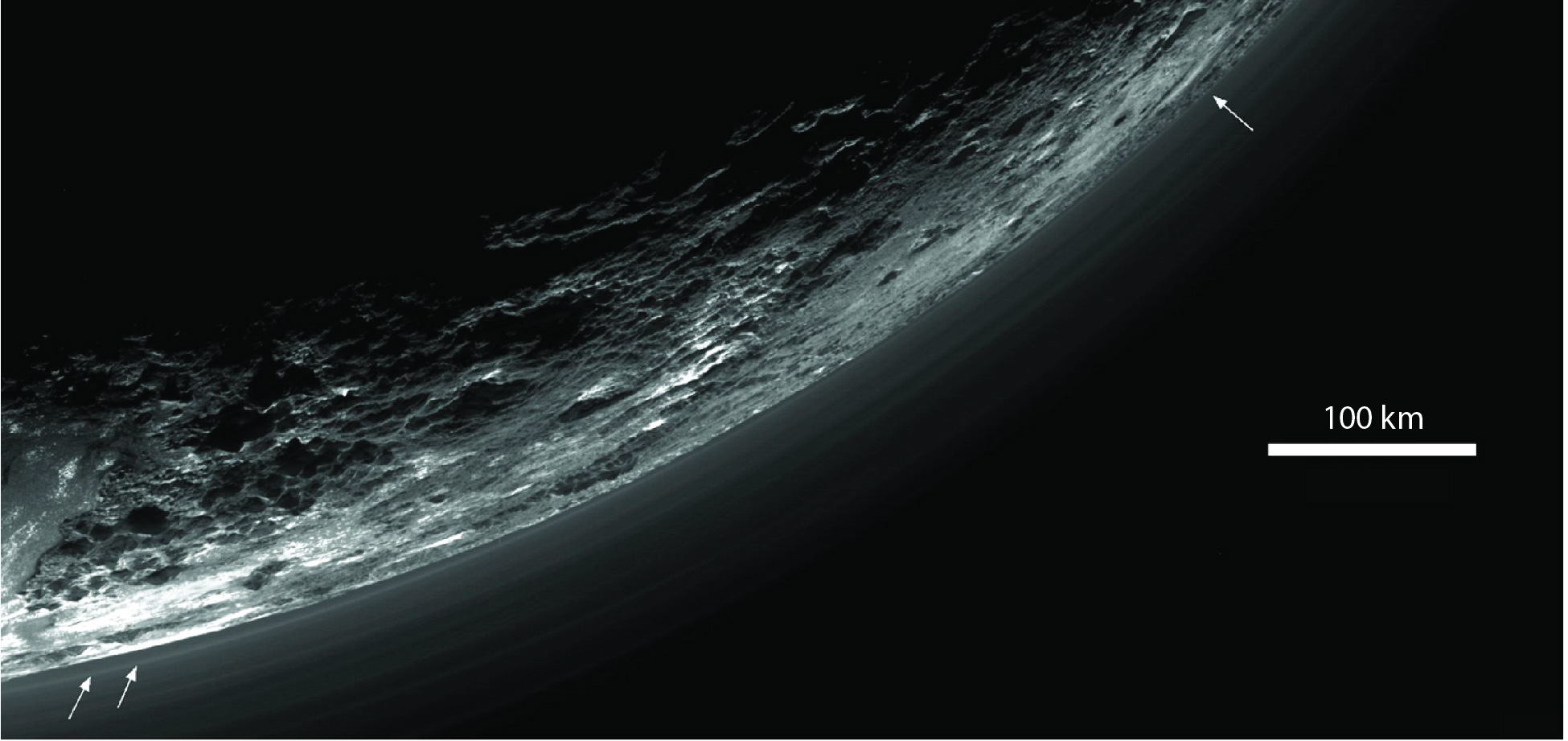
The northern polar region of Pluto has been named Lowell Regio (Figure 13.1). Because of its location, Lowell Regio experiences long periods of darkness (winter) and light (summer). These long periods of continual sunlight (or absence of it) cause fluctuations in the temperature at this location that determine if there will be net deposition or sublimation of volatiles. During the winter volatile ices are deposited and during the polar summer the ices sublimate. This creates a seasonal transfer of volatiles and ice back and forth from pole to pole.
Even though New Horizons only mapped about 40 percent of Pluto's surface, over 5000 impact craters have been identified (Figure 13.13). However, impact crater frequency varies greatly across the surface. Some areas have crater abundances consistent with formation before the Late Heavy Bombardment, while other areas have no identifiable impact craters, suggesting the surface is younger than 10 million years old. The upland plains north and west of Sputnik Planitia are quite heavily cratered and are the oldest terrains of Pluto, with an age of about 4 billion years. In contrast, Sputnik Planitia is the youngest terrain seen on Pluto. No identifiable impact craters are observed on the ice sheet, probably because of the quick overturn of the convection cells. Any crater that impacts the nitrogen ice sheet would be obliterated within 500,000 years. While much of the surface is ancient (around 4 billion years old), Pluto also has enough heat to be geologically active in some places.
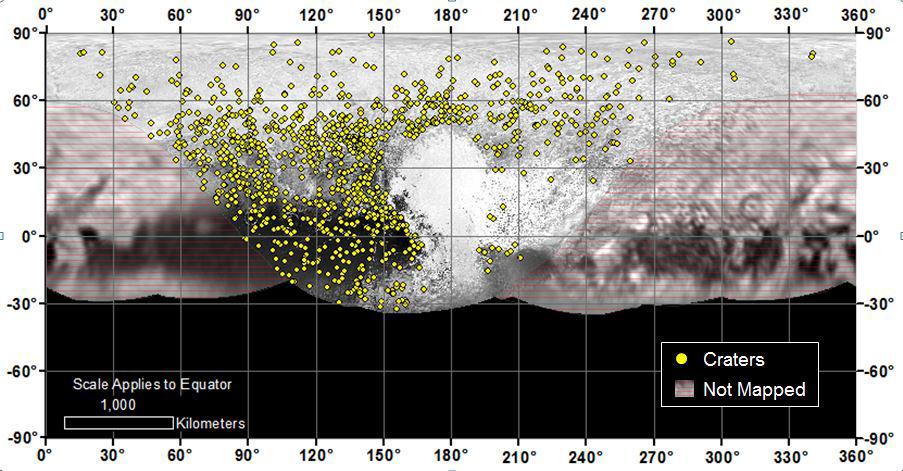
The morphologies of impact craters on Pluto are very similar to those on other icy planetary bodies; with small and simple craters being bowl-shaped, and larger craters having central uplifts. The largest impact crater, Burney (named after the 11-year-old schoolgirl who suggested the name "Pluto" for the planet Clyde Tombaugh discovered), is 220 km across. No large multiring features like those on Ganymede or Callisto have been found on the imaged hemisphere. The ejecta of plutonian craters is hard to discern because it is mostly buried by young ice deposits. Many of the crater floors are dark red, which could be tholins once buried by nitrogen and methane ice, that have been excavated by impact.
Pluto's surface is riddled with extensional tectonic features (Figure 13.14). These include numerous belts of aligned and arcuate troughs that are several hundred kilometers long and a few kilometers deep. They are interpreted to be grabens or rifts bounded by steep normal faults. These fractures branch from and into others, cutting across preexisting landforms and terrains. The tectonic features are variably degraded indicating deformation occurred over a long period of time. For example, Virgil Fossa contains unbroken rift segments up to 200 km long, the eastern end cuts across a large impact crater, while the western edge branches out into many segments (Figure 13.14c). In many ways, the extensional features are similar to those on the moons of Uranus and Saturn, but they are not as complex as the grooved terrain of Ganymede or highly fractured Europa. Importantly, no compressional tectonic features have been identified on Pluto.
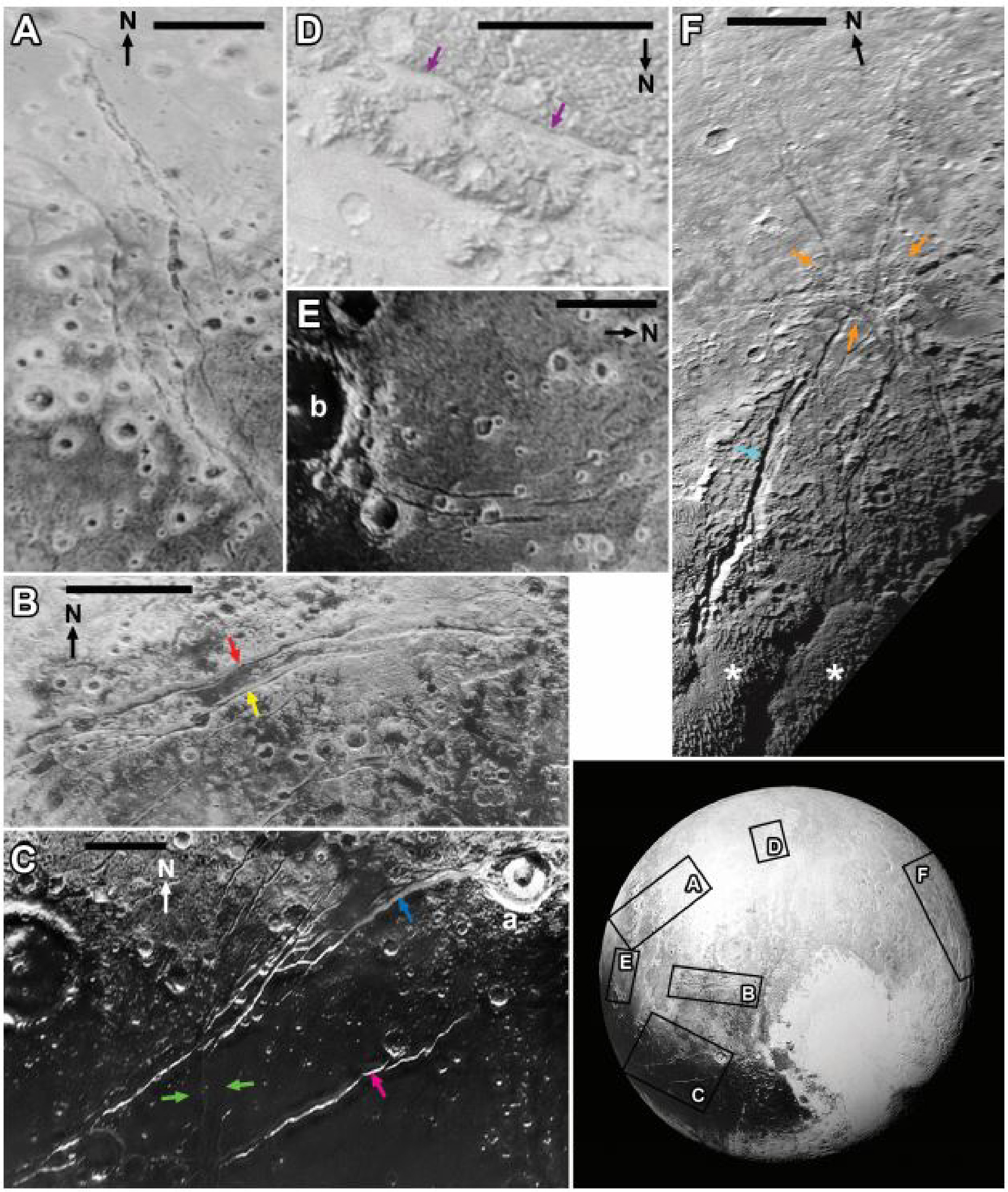
The mechanism of formation for these extensional features is conceptually simple. Early in Pluto's history, most of the water inside Pluto was liquid. As time passed, Pluto lost its internal heat leading to the freezing of the liquid water into ice. Freezing occurred from the top downward. The phase change from liquid water to ice water decreases its density causing expansion during freezing. On a global scale, this freezing and expansion of the subsurface ocean produced extensional stresses at the surface of Pluto and created extensional fractures. The lack of contractional features shows that Pluto did not contract during cooling like the silicate dominated inner planets (for example Mercury).
Because volcanoes are windows into a planet's deep interior that reveal how hot it might be at different times in a planet's history, it is important to find and study volcanic features on other planets. Two possible cryovolcanoes have been identified in the southern hemisphere of Pluto and may give a glimpse into Pluto's interior. In general, these features are large mounds with central depressions. Wright Mons is most morphologically like a cryovolcano (Figure 13.15). It is 3-4 km high and 150 km in diameter and has a central depression that is 5 km deep with concentric rings surrounding the depression. This feature appears to be constructional, made of a series of flows followed by retreat of magma and collapse at the vent. There are very few impact craters on this mound, indicating a young eruption age. The height suggests that it must be made out of materials stronger than nitrogen or methane ice, which flow readily. Most likely, the construct is made of water ice coated by thin deposits other ices. Maybe cryomagma formed in an anomalously warm region of the interior and rose through fractures in the water-ice lithosphere to erupt on the surface. Alternatively, ammonia-rich ice melts at a lower temperature than water ice and could have allowed the creation of cryomagma. But why would it be warmer or compositionally different just in a few places? Do icy plumes reflecting subsurface convection play a role here?
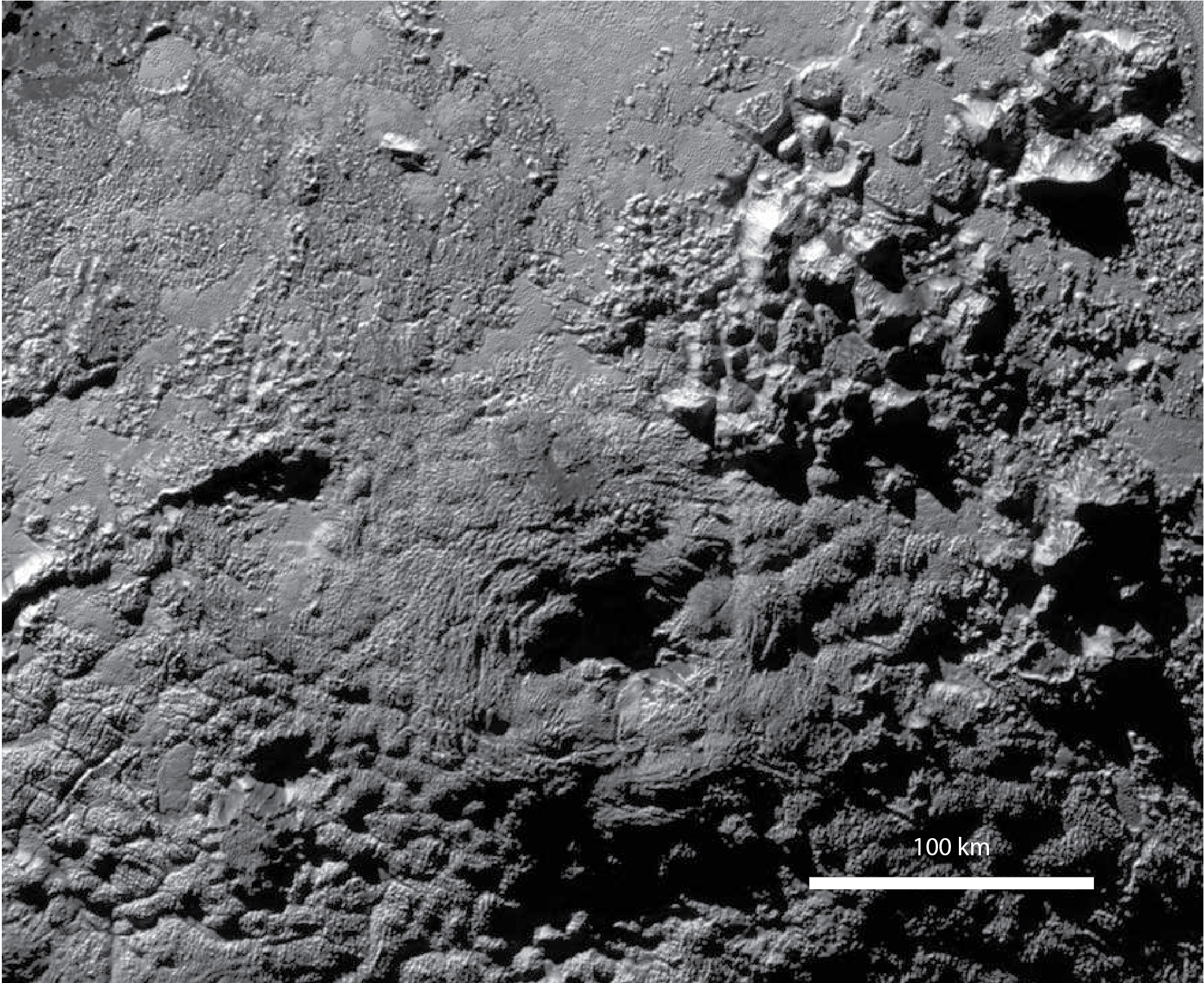
The internal structure of Pluto is similar to the icy moons of the outer planets and probably other Kuiper Belt Objects as well. Pluto's density is 1.9 g/cm3 indicating it is a mix of dense silicates and metals as well as low density ice. It is most likely partially differentiated with a rocky core, a liquid water layer, a water-ice mantle, and a surface veneer of volatile ices (Figure 13.16).

Pluto's core is thought to be 1700 km across, about 70% of Pluto's diameter. The core is probably made of dense silicate rock mixed with some metal. An iron core is unlikely because there may not have been enough refractory metal or enough early accretionary heat to differentiate a metal core from a rocky mantle.
Pluto probably has lower concentrations of radioactive elements than the terrestrial planets; these elements (potassium, uranium, and thorium) condense with silicates rather than in volatile ices. But Pluto must have some radioactive elements concentrated within its rocky core. Perhaps the decay of these elements, or tidal heating, produced enough heat to allow tectonic features to form in a thin, weak lithosphere, form the young cryovolcanoes, and maintain a liquid water layer in contact with the core.
The location of Sputnik Planitia, in regard to its axial tilt, and computer models show Pluto's rocky core is probably surrounded by a layer of liquid water at least 100 km thick below an outer layer of solid water ice. Early in Pluto's history, the liquid water layer was most likely thicker and as Pluto cooled, the liquid water froze, creating a water ice lithosphere that increased in thickness at the expense of the liquid layer. At some point in the future, all the liquid water will be completely frozen.
The outer 200 km are made of a water-ice crust (essentially a rigid lithosphere) capped by the highly volatile surface ices of varying thicknesses. The veneer of ices is composed mostly of nitrogen and methane with lesser amounts of carbon monoxide. Nitrogen is the most volatile ice and tends to concentrate in the coldest locations, such as Sputnik Planitia and the pole experiencing winter (the south pole currently; but we have no images from the south--it not illuminated when New Horizons flew by in 2015; Figures 13.1). Methane is widely distributed, concentrated in the Lowell Regio and the equator (especially in Tartarus Dorsa and the tops of al-Idrisi Montes), but is patchy at the mid-northern latitudes (Figure 13.4). Carbon monoxide is not as common on Pluto as the other ices but is found in high concentrations in the low elevation Sputnik Planitia, along with the other ices. In fact, the Sputnik Planitia basin appears to be a cold trap, becoming a storage location of all the ices as vapors move to low elevations in the thin atmosphere and then condense as solids (Figure 13.4).
Pluto has a low pressure (0.1% of Earth's), nitrogen and methane-rich atmosphere (reminiscent of the volatile surface ices). This atmosphere is sustained by the sublimation of nitrogen and methane ice. In this way, the evolution of the atmosphere and surface ices are tied together.
Pluto has 5 moons that have been discovered thus far (2018): Charon, Styx, Nix, Kerberos, and Hydra (Figure 13.17). Charon (named after Pluto's ferryman) is the largest and closest of the 5 moons. Fortunately, New Horizons was able to collect high-resolution images and other data for Charon, and some things were also learned about the four smaller moons.
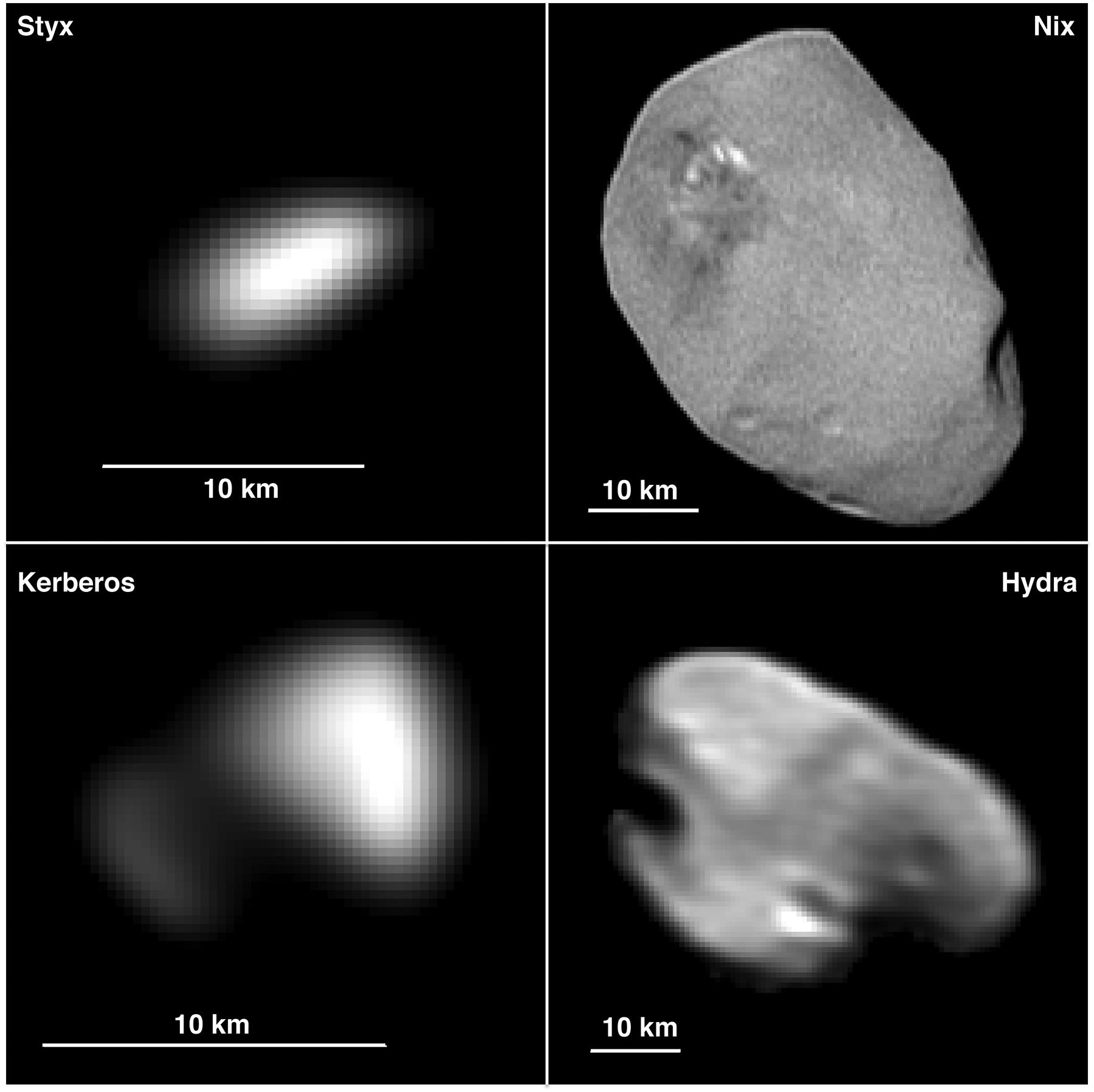
Charon is 1212 km in diameter (about half the size of Pluto) with a slightly lower density than Pluto of 1.7 g/cm3 because of Charon's thick water ice mantle and presence of ammonia ice at the surface. The moon is divided into three main regions that are the result of different processes (Figure 13.18). Charon's northern and southern hemispheres are divided by large, equatorial chasms that span the globe, made of two interconnected rifts. Serenity Chasma is 50 km wide and 5 km deep and Mandjet Chasma has the same width but is 2 km deeper (7 km). Another, separate chasm, Argo Chasma, is 690 km long and 5 km deep. North of the first two chasms lies Oz Terra, a tectonically disrupted terrain with scarps, angular fault-bounded crustal blocks, depressions, and ridges. The crater frequency shows the surface is more than about 4 billion years old. These extensional tectonic features must have formed by the same mechanism as those on Pluto--the freezing of an interior liquid layer causing expansion of the globe.
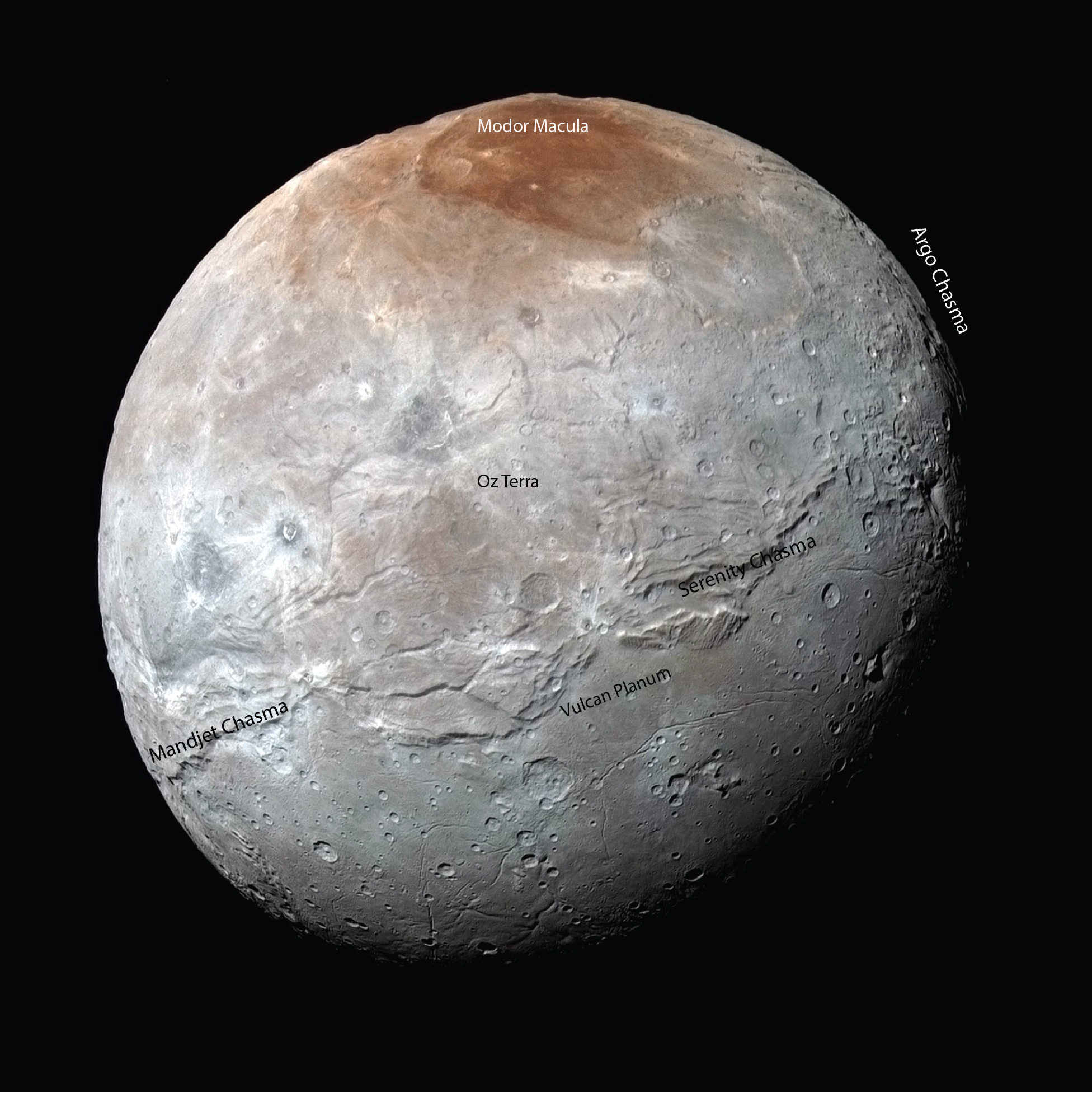
Mordor Macula, Charon's north polar region, is covered with dark red material, similar to Cthulhu Macula on Pluto (Mordor was the Dark Land in Tolkien's The Lord of the Rings.) The material gets darker with increasing latitude, presumably because the deposit gets thicker. The polar location and dark red color indicate emplacement by seasonal deposition/trapping and then alteration of methane in what may originally have been a large impact basin. Right now, the north polar region of Charon is in the middle of a 150-year-long summer season, while the south pole is in winter (Charon faces Pluto and shares the same orbital tilt). Amazingly, the red material may not come from Charon at all, but instead it traversed thousands of kilometers from Pluto to fall on Charon. These volatiles are probably derived from Pluto by sublimation of methane ice that then escapes from Pluto's atmosphere and makes its way to Charon. The methane is then deposited on the pole experiencing winter. As the pole moves into the Sun the methane reacts with the radiation and becomes refractory, making tholins in the atmospheres of Pluto and Titan.
The southern hemisphere, called Vulcan Planum, is not as broken up as the northern hemisphere. It is made of smoother plains with fields of small hills 2-3 km in width, and moated mountains, which may be of cryovolcanic origin (Figure 13.19). The crater density of Vulcan Planum is slightly less than Oz Terra indicating a younger surface that may have been cryovolcanically resurfaced.
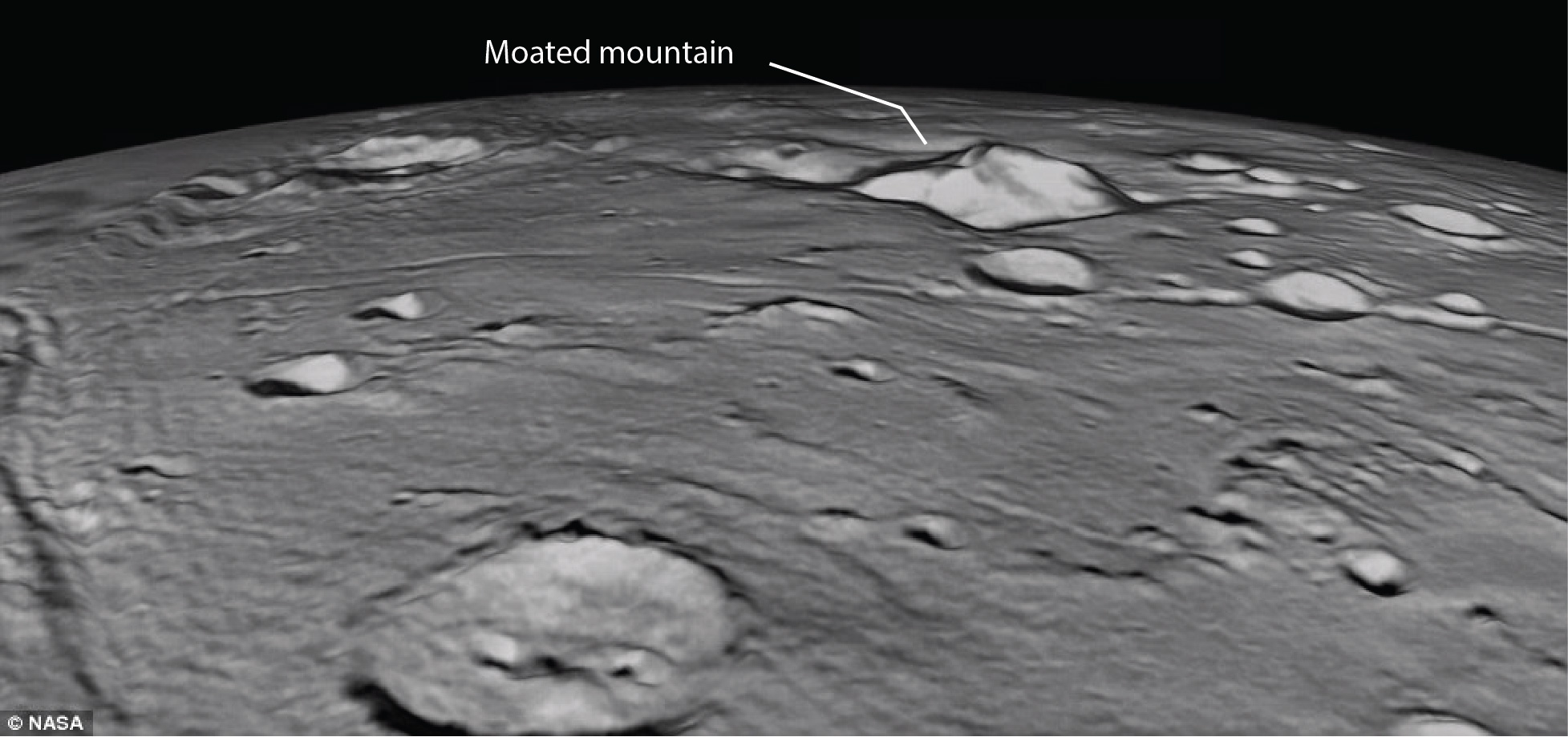
Not much is known about the other moons of Pluto. They orbit Pluto at a greater distance than Charon and are much smaller, ranging from 10 to 37 km across. They are bright, porous, undifferentiated bodies that did not become large enough to become spherical. They all have nearly circular orbits but chaotic, nonsynchronous rotations; they are not tidally locked with one face toward Pluto. Because of these irregularities, it is speculated that they are giant hunks of ice ejected from Pluto in some past impact event, perhaps during the event that formed the Pluto-Charon system.
Pluto condensed far from the Sun where nitrogen, methane, and carbon monoxide were stable, and it accreted from these ices and silicates; however, there was not enough material to create a large planetary body like Saturn or even Neptune. Charon and Pluto's other moons may have accreted from material that was orbiting Pluto. Alternatively, a more dramatic event may have created the moons. Soon after accretion, when Pluto had begun to differentiate, it could have been hit by a large body. This scattered proto-Pluto and the impactor into many pieces that then reaccreted to form Pluto, Charon, and the other small moons, similar to the impact that formed the Earth's Moon.
Just as interesting as the formation of Pluto's moons is the evolution of this planet's orbit. Initially the orbit and axial tilt of the plutonian system may have looked like any other planetary system. However, the Gas Giant bullies changed Pluto's orbit forever. As the Gas Giants migrated outward from the Sun (the event that may have initiated the Late Heavy Bombardment), they may have gravitationally pushed Pluto onto its side and forced it to roll around the Sun in an elongated and inclined orbit. Or perhaps the collisional event that formed Charon also imparted a skewed inclination to the planetary bodies.
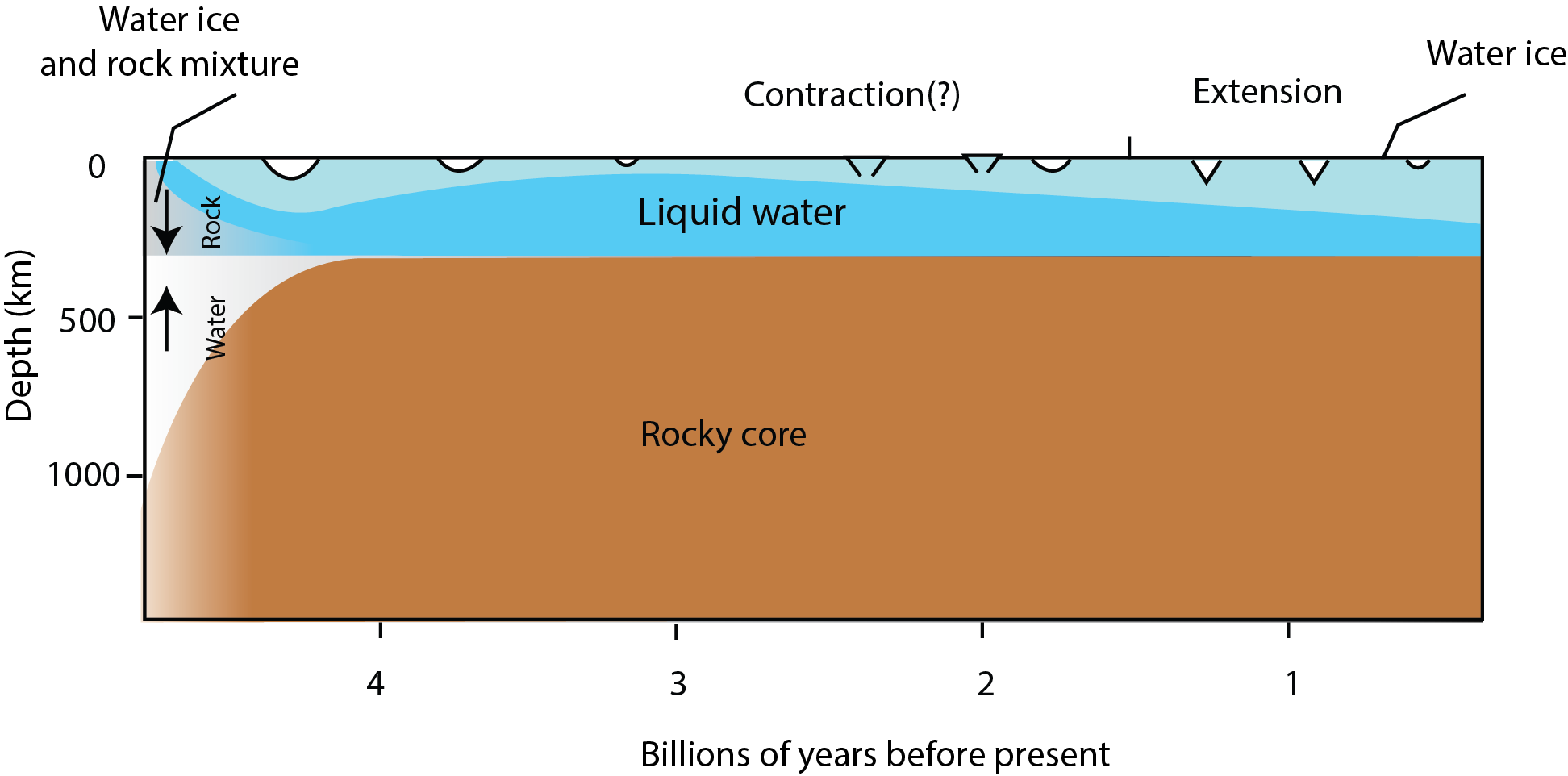
Regardless of how Pluto and its moons formed, the thermal and geologic history of Pluto is similar to other icy bodies (Figures 13.20 and 13.21). Pluto differentiated quickly, with dense rocky materials sinking to the center of the planet within thousands of years. Soon after differentiation, the outermost part of Pluto began to freeze as water ice. Concurrent with cooling, Pluto degassed, releasing volatile gases that formed an atmosphere. Some of these volatiles (nitrogen, methane, and carbon dioxide) condensed onto the surface as ices. As Pluto continued to cool and the lithosphere continued to thicken, a large impactor hit Pluto, forming the basin called Sputnik Planitia. Volatiles accumulated in the low, cold basin, freezing out to form a vast, nitrogen ice sheet with peripheral glaciers. As Pluto outgassed and impacts occurred, the planet continued to cool, its water ice lithosphere thickening at the expense of a subsurface liquid water layer. With continual freezing, the water ice lithosphere expanded, producing long extensional tectonic grabens and fractures. However, Pluto is not completely frozen yet, and still has enough heat to sustain a 100 km thick liquid water layer, local cryovolcanoes, and tectonic activity. One day the heat will run out and Pluto will be a completely frozen planet, like Charon. Then only geologic processes related to the atmosphere (dunes and bladed terrain), sunlight (sublimation, deposition, tholin production), and light impact cratering will occur.
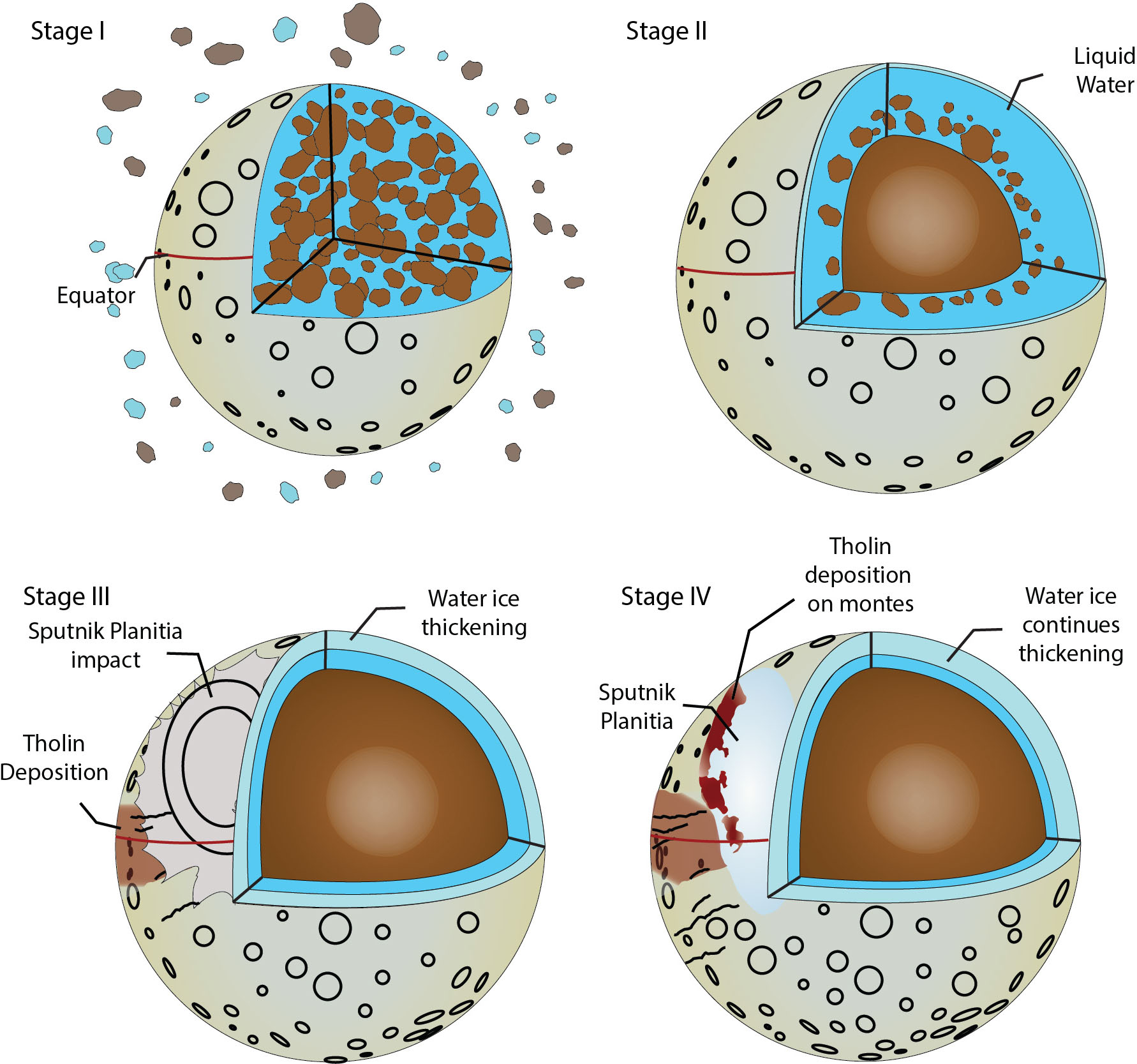
The Kuiper Belt lies in the distant outer solar system and is composed of small planetary bodies called Kuiper Belt Objects (KBOs), of which Pluto was the first to be discovered (Figure 13.22). The Kuiper Belt extends from about 30 AU (near the orbit of Neptune) to 50 AU from the Sun and is shaped like a large donut (Figure 13.22). Millions of small (Pluto being the largest), diversely shaped, and icy bodies are probably located there. Very few specifics are known about KBOs; however, telescopic observations of some KBOs (including Eris), the flyby of Pluto, and of newly discovered Arrokoth have given important insights regarding the formation and evolution of the Kuiper Belt.
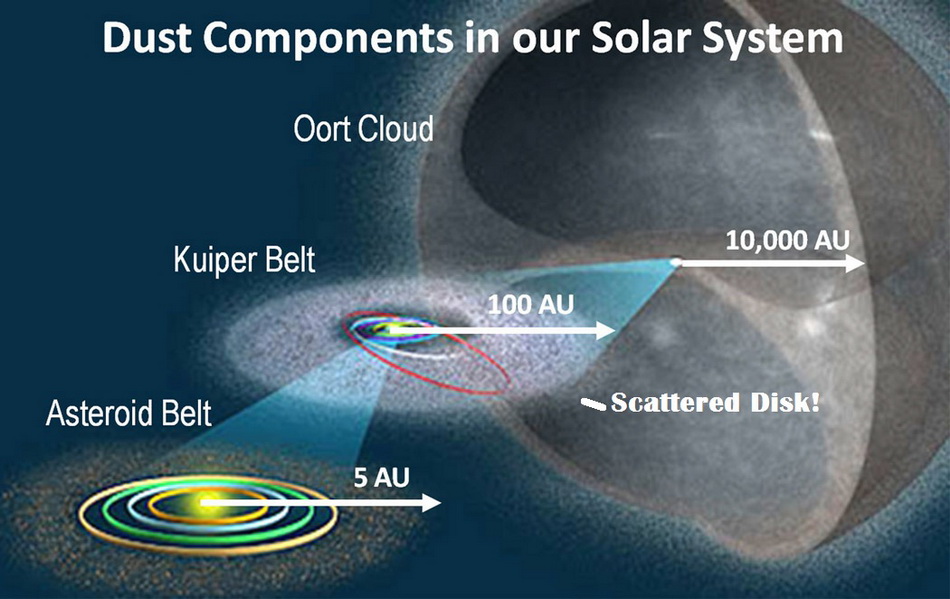
The formation of the Kuiper Belt started with the condensation of gases into ices (including water, methane, and ammonia) along with various amounts of silicate rock in the region near Neptune. Accretion of these materials followed condensation but was never completed. Like the asteroid belt, the Kuiper Belt is an area of failed accretion, a result of the interfering gravity of Neptune keeping these icy materials from growing into one large planet. Soon after the formation of the KBOs, changes in the orbits of Jupiter and Saturn perturbed the orbits of Uranus and Neptune, causing the two ice giants to move farther away from the Sun. The change in Neptune’s orbit gravitationally scattered many of the KBOs into their present positions, while some moved into the Oort cloud and others were completely ejected from the Solar System.
Following its flyby of Pluto, New Horizons buzzed past tiny Arrokoth in 2019. It turns out to be complex assemblage of bodies (Figure 13.23). After a “gentle” low-velocity collision between the two lobes, Arrokoth stuck together as a single spinning body. Because the bodies did not destroy each other, the collision may have been like slow parking lot accident with two cars. The larger walnut-shaped part is itself a composite of building blocks brought together by accretion. A bright ring marks the contact between the two bodies; it may be composed of small fragments that rolled down into the suture. Several large and small craters dot the surface but appear to lack ejecta and blocky rims. The largest are likely to be impact craters, but the small aligned pits on its edge may be from volatile release and collapse. Tholins (like those formed on Pluto and Charon) derived from solar radiation on methane ice probably give Arrokoth its reddish color. Water ice and methanol have also been detected on the surface and there is probably ammonia as well. These are exactly what we would expect in the far distant reaches of the Solar System where low temperature ices dominate.
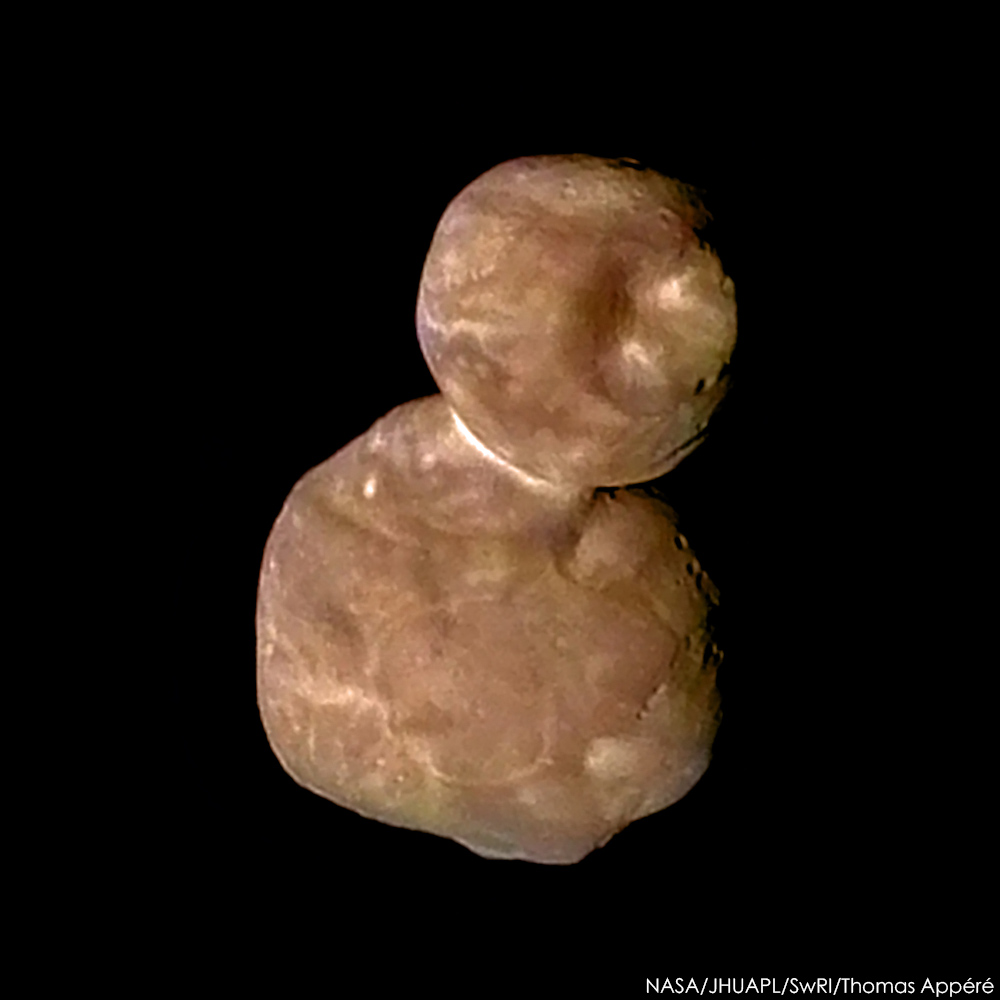
The expectation of Pluto being geologically dead was summarized nicely by Nimmo and Spencer (2015): "Pluto does not experience significant tidal heating and is predicted to show no signs of recent resurfacing". However, New Horizons showed an active Pluto with many geologic features we have seen on other planets and icy moons--especially Neptune's Triton and Saturn's Titan. These include impact craters, tectonic scarps, and cryovolcanoes. But the variety of volatile ices (methane, nitrogen, and carbon monoxide) leads to the most rapid surface changes and produces many familiar and unfamiliar, even exotic surface features.
Pluto has a rocky inner core that makes up 2/3 of the planet's diameter, surrounded by a liquid water layer, a water-ice mantle, and a dusting of nitrogen and methane ices. Most of Pluto's surface is dotted with impact craters and surfaces that date back to 4 billion years ago. However, the basin of Sputnik Planitia is very young with its convecting nitrogen-rich ice sheet. Active glacial flow from the pitted uplands into Sputnik Planitia occurs today and valleys show evidence of past glaciation in other locations.
Sublimation and deposition of volatile ices and wind-blown deposition are the dominant geologic process on Pluto today, forming pits, penitentes, and dunes across the surface. Extensional features show rift tectonics dominated Pluto's history penultimate history, most likely caused by the freezing of a liquid water layer. Constructional mounds in the southern hemisphere may be evidence for recent past cryovolcanism where water lava erupted onto the surface. The unexpected geologic activity on Pluto has important implications for how long it takes icy planetary bodies to cool, how the Sun can affect planetary surfaces, and how long bodies are geologically active. Continued study of Pluto and the geologic processes acting on the planetary body will give more insight into how icy planets form and evolve and will show important contrasts with terrestrial planetary evolution.